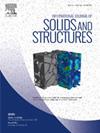基于Krylov延迟修正技术的高阶GFDM双材料界面裂纹动态分析
IF 3.4
3区 工程技术
Q1 MECHANICS
International Journal of Solids and Structures
Pub Date : 2025-05-11
DOI:10.1016/j.ijsolstr.2025.113451
引用次数: 0
摘要
本文介绍了一种高阶数值方法来模拟动态载荷下双材料介质中的界面裂纹。对于弹性动力系统的离散化,所提出的数值框架采用增强的Krylov延迟校正(KDC)方法进行时间离散化,并结合高阶广义有限差分法(GFDM)进行空间离散化。增强的KDC技术采用精确的数值实现策略来精确匹配边界条件。在GFDM中,裂纹尖端附近采用四阶泰勒级数展开,而远场采用二阶展开。在裂纹尖端附近采用节点细化技术,提高了数值精度。这种增强的KDC和高阶GFDM的集成允许对大时间步长的动态界面裂缝进行高精度模拟。大量的数值实验验证了该方法在处理冲击载荷下双材料动态界面裂纹问题中的有效性。最后,将该方法得到的动态应力强度因子与有限元法和边界元法得到的动态应力强度因子进行了比较。本文章由计算机程序翻译,如有差异,请以英文原文为准。
Dynamic analysis of bi-material interfacial cracks by the high-order GFDM with an enhanced Krylov deferred correction technique
This work introduces a high-order numerical methodology for simulating interfacial cracks in bi-material media under dynamic loadings. For discretizing the elastodynamic system, the proposed numerical framework utilizes an enhanced Krylov deferred correction (KDC) method for temporal discretization, integrated with the high-order generalized finite difference method (GFDM) for spatial discretization. The enhanced KDC technique incorporates a precise numerical implementation strategy to accurately match the boundary conditions. In the GFDM, the fourth-order Taylor series expansions are utilized near the crack tips, whereas second-order expansions are employed in the far-field. A node refinement technique is applied in vicinity of the crack-tips to improve the numerical accuracy. This integration of the enhanced KDC and the high-order GFDM allows for highly accurate simulations of dynamic interface cracks with large time steps. Extensive numerical experiments validate the effectiveness of this method in addressing bi-material dynamic interface crack problems under impact loadings. Furthermore, the dynamic stress intensity factors (DSIFs) generated through the proposed approach are compared with those obtained from the finite element method (FEM) or the boundary element method (BEM).
求助全文
通过发布文献求助,成功后即可免费获取论文全文。
去求助
来源期刊
CiteScore
6.70
自引率
8.30%
发文量
405
审稿时长
70 days
期刊介绍:
The International Journal of Solids and Structures has as its objective the publication and dissemination of original research in Mechanics of Solids and Structures as a field of Applied Science and Engineering. It fosters thus the exchange of ideas among workers in different parts of the world and also among workers who emphasize different aspects of the foundations and applications of the field.
Standing as it does at the cross-roads of Materials Science, Life Sciences, Mathematics, Physics and Engineering Design, the Mechanics of Solids and Structures is experiencing considerable growth as a result of recent technological advances. The Journal, by providing an international medium of communication, is encouraging this growth and is encompassing all aspects of the field from the more classical problems of structural analysis to mechanics of solids continually interacting with other media and including fracture, flow, wave propagation, heat transfer, thermal effects in solids, optimum design methods, model analysis, structural topology and numerical techniques. Interest extends to both inorganic and organic solids and structures.

 求助内容:
求助内容: 应助结果提醒方式:
应助结果提醒方式:


